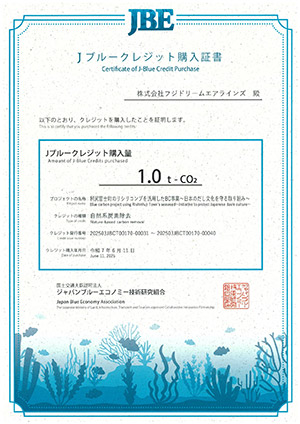Environmental Initiatives
FDA aims to be an environmentally friendly airline by reducing greenhouse gas (CO2) emissions in order to contribute to the sustainable development of society. In order to reduce greenhouse gas (CO2) emissions, we are working on introducing new technologies, improving flight operations, and utilizing alternative aviation fuels.
Flights using renewable jet fuel (SAF)
In March 2022, the FDA conducted a flight using Euglena Co.'s biofuel "Susteo" (the brand name of the biofuel manufactured and sold by Euglena Co.). Susteo is the name of the biofuel manufactured and sold by Euglena Co., Ltd., and is made from used cooking oil and algae such as Euglena.
Biofuels emit CO2 during the combustion stage, but since both the plants and Euglena, the raw materials for the used edible oil used as raw materials, absorb CO2 through photosynthesis during their growth, they are expected to contribute to the realization of carbon neutrality, where CO2 emissions from the use of the fuel are essentially zero. Furthermore, Susteo's SAF is the first in the world to be certified to the ASTM D7566 Annex 6 standard.
FDA, in cooperation with Suzuyo Shoji, a member of the Suzuyo Group that is responsible for procuring and supplying aviation fuel, and in cooperation with Euglena Co., conducted a charter flight between Mt. Fuji Shizuoka Airport and Prefectural Nagoya Airport (Komaki) on March 16, 2022. FDA will continue to consider the full-scale introduction of biojet fuel in the future and will continue to work toward a decarbonized society.

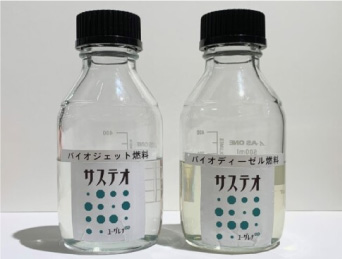
Improved flight operations
FDA is working with flight engineering departments and pilots to optimize flight procedures and routes to reduce fuel consumption.
For example, is the engine power appropriate for the flight to the destination? What is the best cruising altitude, taking comfort into account? What is the cruising speed? At what point should the aircraft prepare for landing, and how much engine power can it reduce? We calculate and calculate fuel consumption in detail for various factors based on past flight data, and provide this information to pilots. We work to reduce fuel consumption by repeatedly verifying whether the theoretically derived reduction target figures are correct using a flight simulator, a flight training device, and accumulating feedback from pilots who have actually flown.
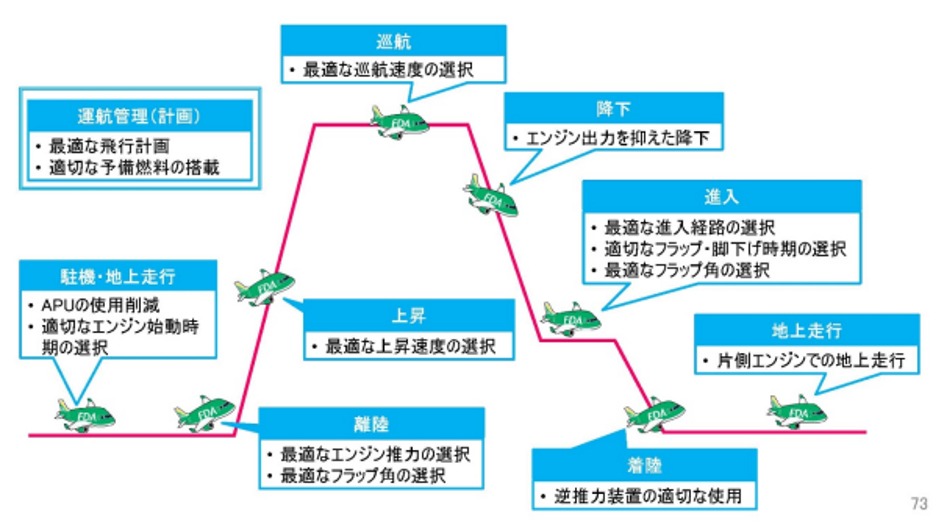
The flight phase in which an aircraft can reduce fuel consumption the most is the "cruise section," but because FDA's average flight time is short at 75 minutes, the "cruise section" alone is not enough to reduce fuel consumption and CO2 emissions. For this reason, as shown in the figure, we are working on various measures for the entire flight, including "takeoff and climb," "descent and approach," and even "taxiing." Here are some of these measures.
■ Flight speed verification using a flight simulator
Since the actual operating environment (weather conditions, air traffic congestion, etc.) is constantly changing and it is difficult to uniquely determine the optimal conditions for reducing fuel consumption and CO2 emissions, we use a flight simulator to consider measures.
[Calculating the flight speed that provides the best fuel efficiency when flying into a headwind]
Generally, the lower the air density, the lower the fuel consumption when flying at a higher altitude and at a slower speed, but flying at a slower speed increases the flight time, which not only increases fuel consumption but also reduces punctuality. In addition, the westerly winds known as the jet stream constantly blow above Japan, and the higher the altitude, the stronger they become, with wind speeds reaching 100 m/s in winter.
In that case, flying slower may not necessarily be the most fuel-efficient option for the entire flight.
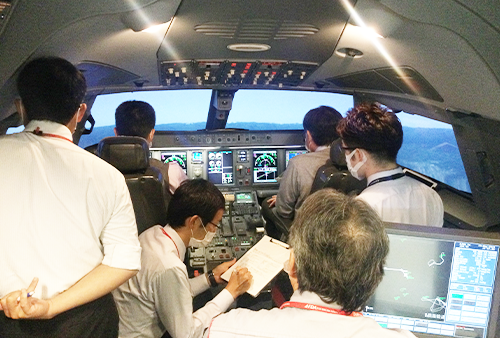
For example, if you are currently flying at a cruising altitude of 9500m (31000ft) at a speed of 420kt (M0.72), your fuel economy will be 0.13km/L (0.12NM/lb). If you accelerate from this state to a speed of 460kt (M0.78), your fuel economy will decrease to 0.12km/L (0.11NM/lb). Based on this condition, if we consider the effect when there is a 100kt headwind, fuel consumption will be 0.92 times (0.12/0.13), which is a loss of 8%. However, on the other hand, the ground speed will increase from 320kt (420-100) to 360kt (460-100), which is 1.12 times (360/320), resulting in a 12% gain. Fuel consumption on the ground will improve by 1.03 times (0.92 x 1.12), which can be said to have had an acceleration effect.
The optimum fuel-efficient speed varies depending on the strength of the headwind, flight altitude, and flight weight, so we collect data using a flight simulator.
[Comparison of fuel consumption during slow, rapid climb and fast, gentle climb]
Aircraft fly by using the surplus thrust generated by the engines minus the resistance of the aircraft to climb or accelerate. In other words, if you fly at high speeds, the rate of climb will worsen to the extent that excess thrust is used for acceleration, and it will take longer to reach cruising altitude. The higher the altitude, the stronger the westerly winds become, so the fuel consumption for the entire flight will depend on the strength of the headwind at cruising altitude. There are two options: a gradual climb at high speed to shorten the flight time at cruising altitude where the westerly winds are strong (climbing: high fuel consumption, cruising: short flight time), or a rapid climb at low speed to lengthen the flight time at cruising altitude (climbing: low fuel consumption, cruising: long flight time). These are verified using a flight simulator and are utilized in daily operations.
■ Implementation of noise abatement takeoff method
In order to reduce the impact of aircraft noise on the surrounding areas, each airport has a takeoff procedure that reduces noise. Different takeoff procedures are set for each airport depending on the conditions around the airport, but when multiple procedures are set, the takeoff procedure that consumes less fuel is implemented. As an example, if NADP1 (Noise Abatement Departure Procedure 1) and NADP2 are possible, implementing NADP2 can reduce fuel consumption by 8L (15lb) from takeoff to an altitude of 3000m (10000ft).

■Implementation of RNP AR approach
Some airports have a high-standard approach method that utilizes GPS, called the RNP AR approach. The FDA has received special permission for the aircraft and pilots required to perform this approach method. The RNP AR approach is characterized by a circular route that is set until just before landing, and the route can be safely flown using the navigation system, making it possible to safely fly the shortest route along the mountain valleys even at airports surrounded by mountains, such as Shinshu Matsumoto Airport. By implementing the RNP AR approach at Shinshu Matsumoto Airport, it is possible to reduce fuel consumption by 120L (200lb) compared to other approach methods.
■ Issuance of SMART FUEL
The flight operations department regularly publishes an information medium called "SMART FUEL" to visualize fuel reduction results and promote activities.
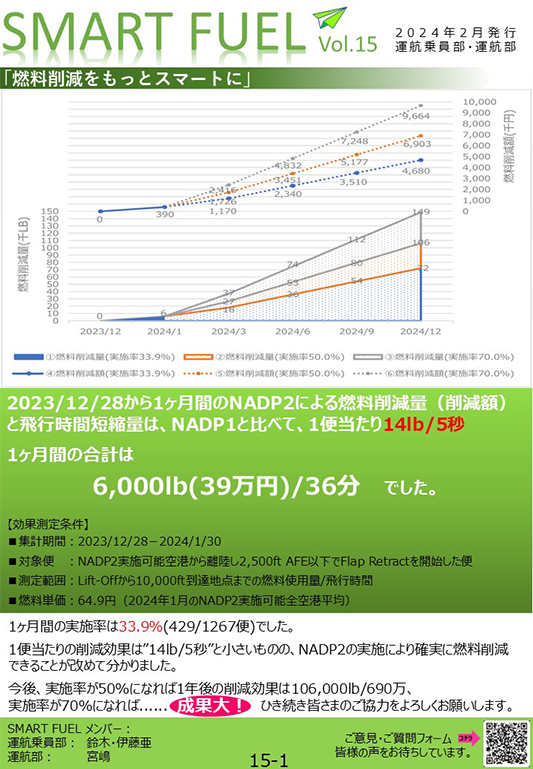
Use of fuel-efficient aircraft
FDA is working to reduce unnecessary air resistance and the amount of fuel used for operation by changing the shape of parts of the Embraer aircraft it operates (improving fuel efficiency). Specifically, the wheel covers, wing tips, and wingtip shapes have been changed to reduce air resistance.
In 2015, FDA introduced the first aircraft in Japan that has been fitted with Embraer's fuel efficiency improvement package, Fuel Burn Improvement (Package 2). This has resulted in a fuel efficiency improvement of approximately 5.5%.
■ Change the winglet shape to a wing tip
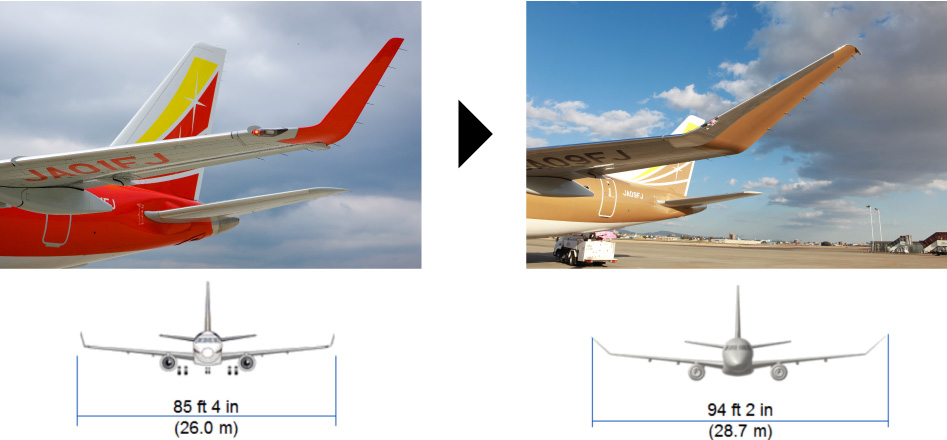
■ Use of wheel covers

■ Changes to the shape of the ram air door and APU area

■Reduction of power consumption by adopting LED beacons

Airport decarbonization initiatives
Aircraft account for the majority of carbon dioxide emissions, but a certain amount also comes from vehicles and ground equipment used at airports, and reductions are required. Measures that airlines can implement include electrifying vehicles and ground equipment that use fossil fuels such as gasoline and diesel, and switching the electricity they use to so-called green electricity that uses renewable energy sources such as solar power.
■ Introduction of battery-powered vehicles (eGPU)
In the explanation of the improvements to flight operations, there is an item on reducing the use of APUs (auxiliary power units) as a measure to be taken while parked and on the ground. FDA is also working on using power generating units (GPUs) instead of APUs as a power source while parked, but these GPUs also use gasoline or diesel as fuel, making them a major source of carbon dioxide emissions at the airport. FDA will be introducing eGPUs for the first time in February 2024 and deploying them at Nagoya (Komaki) Airport, working to further reduce carbon dioxide emissions.
The eGPU introduced is the first domestically produced eGPU for aircraft, developed by AGP Corporation.
It is expected that carbon dioxide emissions will be reduced to about one-tenth compared to APUs and about one-third compared to diesel-powered GPUs.
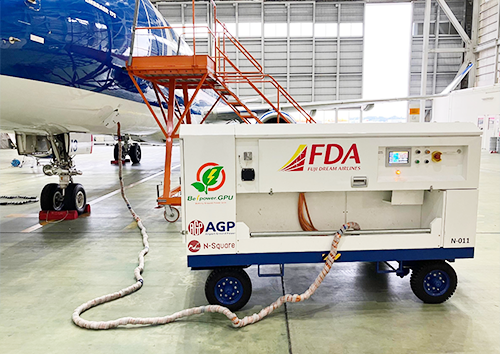
■ Introduction of solar power generation
We are currently working with Suzuyo Shoji Co., Ltd. on a plan to secure green electricity by installing solar panels on the roof of our hangar at Nagoya (Komaki) Airport and generating solar power. Once this is completed, it will further promote decarbonization at Nagoya (Komaki) Airport.
■ Participation in the decarbonization promotion council at airports served
In line with the revision of the Aviation Act in 2022, FDA's airports have also begun efforts to formulate decarbonization promotion plans, and decarbonization promotion councils are being launched one after another. FDA has established a system in which, upon request from the airport, the branch manager is asked to participate in the council, and the head office provides logistical support.
Cooperation with Kasugai City's "Carbon-Free Environment Seminar"
Starting in 2021, Kasugai City, Aichi Prefecture, will be holding an experiential course for elementary school students and their parents to learn about global warming countermeasures being undertaken by airlines that utilize airport resources. FDA is cooperating with this initiative, holding lectures on global warming and aircraft tours. This initiative is based on the "Partnership Agreement on Power Supply to Public Facilities and Zero Carbon Promotion" concluded between Suzuyo Electric Power Co., Ltd. (a joint venture between Suzuyo Shoji Co., Ltd. and Electric Power Development Co., Ltd.) and the city, and is based on the memorandum of understanding that FDA signed with Kasugai City on promoting global warming countermeasures.
*The photo shows the event taking place on February 8, 2025.

Promoting recycling activities
■ Recycling abandoned items at security checkpoints
Most of the items abandoned at security checkpoints are bladed items such as scissors and knives, which have been disposed of as industrial waste up until now. However, after learning that the Gifu Prefecture Seki Cutlery Industry Association was conducting a knife recycling activity, we began sending abandoned cutlery items at Nagoya (Komaki) Airport to the Seki City Cutlery Hall run by the association.
Seki City Cutlery Hall website: http://seki-japan.com/recycle/
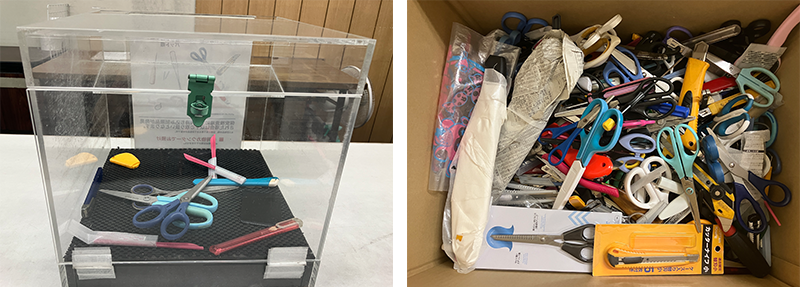
■Eco Cap Activities
FDA supports the activities of the Japan Committee Vaccines for the World's Children (JCV) and participates in activities to provide polio vaccines and other vaccines to children around the world through recycling of plastic bottle caps. The total amount collected is about 200,000, which is equivalent to 235 polio vaccines. We are working on this project with the hope that the daily actions of each employee can be of some help.
The collected plastic bottle caps are handed over to a collection company, and a portion of the purchase price is donated to be turned into recycled plastic resources.
Official website of the certified NPO Japan Committee Vaccines for the World's Children: https://www.jcv-jp.org/
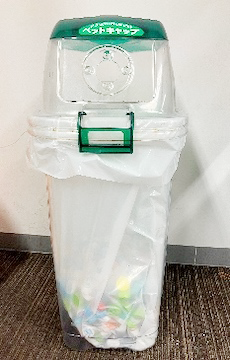
■ Recycling contact lens cases
Since 2023, FDA has been supporting the "Eye City Eco Project" undertaken by the Eye Care Company of HOYA Corporation, and is collecting and recycling empty disposable contact lens cases. The entire amount of the proceeds from selling the empty cases to recycling companies is donated to the Japan Eye Bank Association (public interest incorporated foundation).
Eye City eco project website: https://www.eyecity.jp/eco/
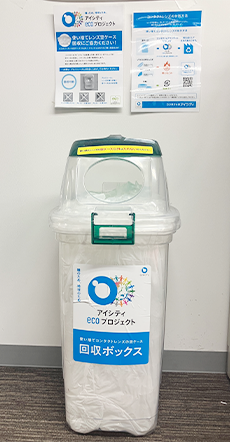
Other Initiatives
■Improve fuel efficiency by washing the engine with water
Engine performance is monitored daily and the engine is washed with water as necessary. This washing is expected to improve the engine's fuel efficiency, which in turn reduces fuel consumption and therefore carbon dioxide emissions.
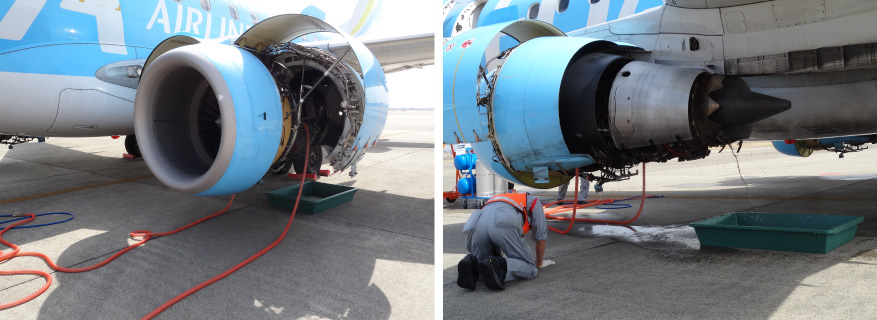
■ Reducing plastic products
We are carrying out various activities with the aim of reducing the use of plastic products in the aircraft accessories provided to customers on board. As one of these activities, from April 2022, we will be switching the stirrers and straws provided in our in-flight services to plastic-free "wooden stirrers" and "biomass straws."

■ Reduction of packaging vinyl
In order to reduce disposable plastic products from an environmental conservation perspective, FDA will, in principle, stop providing plastic bags to pack checked baggage from March 2022. We will continue to provide plastic bags for strollers and wheelchairs. We ask for your understanding and cooperation.
■ Promoting paperless operations
By digitizing manuals and other documents used in operations from paper, we are trying to reduce paper usage. The photo shows the manuals used by flight crew members. Currently, all manuals have been digitized and flight crew members can view them on the tablet devices they are provided with, which is also helping to improve work efficiency.

FDA Carbon Offset Initiative
- Participating in a blue carbon project utilizing Rishiri kelp in Rishirifuji Town -
FDA contributed to carbon offsetting*4 through the purchase of "J Blue Credits"*3 issued by the Japan Blue Economy Technology Research Association (JBE) *2 for the climate change mitigation project "Blue Carbon *1 Project Utilizing Rishirifuji Town's Resilient Silicon Blue - An Initiative to Preserve Japan's Dashi Culture," promoted by Rishirifuji Town in Hokkaido, where Rishiri Airport, the destination of the charter flight, is located, and the Rishiri Fisheries Cooperative Association.
[Business overview]
Rishirifuji Town's main product, Rishiri kelp, saw a major drop in production in 2017. The town felt a strong sense of crisis that the progression of global warming could lead to the extinction of kelp, and focused on the possibility that Rishiri kelp could contribute to maintaining and expanding the CO2 absorption source through the blue carbon ecosystem. As a climate change mitigation project, the town launched the "Blue Carbon Project Utilizing Rishirifuji Town's Rishiri kelp - An initiative to preserve Japan's dashi culture."
Stable production of Rishiri kelp contributes to maintaining and expanding the CO2 sink, and implementing climate change mitigation measures will help preserve Rishiri kelp seeds, which in turn will help "protect Japan's dashi culture" by increasing kelp consumption.
[Terminology]
*1 Blue Carbon
Carbon dioxide (CO2) derived from marine ecosystems such as mangroves, seagrass beds, and salt marshes is sequestered and stored. Japan has the sixth longest coastline in the world, making it highly likely to become an important CO2 sink toward achieving carbon neutrality. In recent years, this has been attracting attention from the national and local governments, private companies, and others.
*2 Japan Blue Economy Technology Research Association (JBE)
A technology research association approved by the Ministry of Land, Infrastructure, Transport and Tourism (MLIT) established in July 2020 to promote climate change countermeasures in coastal areas, conduct experimental research on quantitative assessment of blue carbon generated by marine plants, develop technologies, and introduce financial mechanisms.
*3 J Blue Credit
JBE issues and manages its own proprietary credits after being reviewed and certified by an independent third-party committee. JBE is conducting research and development into the design of a system for reviewing, certifying, and issuing "J Blue Credits" as a new credit, in order to accelerate efforts to mitigate and adapt to climate change in coastal and marine areas, as well as the role of blue carbon ecosystems as CO2 sinks.
*4 carbon offset
After making efforts to reduce one's own CO2 emissions in order to achieve net zero, emissions that cannot be reduced to zero can be adjusted by purchasing CO2 reductions and absorptions from others (i.e., carbon offsetting).
